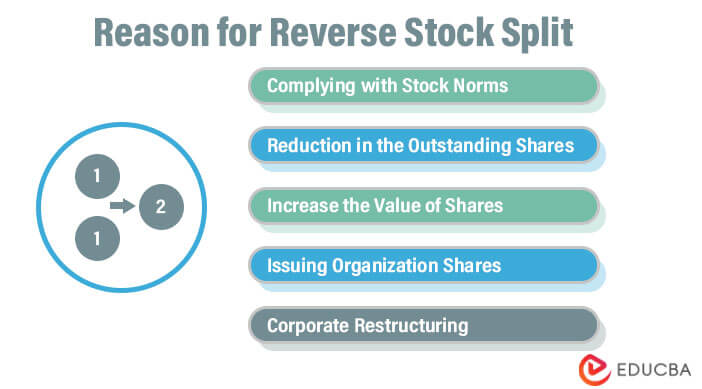Updated July 12, 2023

Definition of Reverse Stock Split
Reverse Stock split is the type of action in which a company consolidates the number of shares outstanding into a lesser number of stocks so as to increase its per share value in the market without affecting the total value of share capital held by the organization and it is generally based on some predetermined ratio.
Explanation
Stock Split is also called merge stock in which the organization consolidates the number of shares. For example, the organization has 10,000 shares of $ 10 each but the organization wants to consolidate the value of shares into $ 100. So, the stock is merged as 1,000 shares of $ 100 each this way the share capital remains the same i.e. $ 100,000. This increases the value of stock in the market as the value of stock changed to $ 100 from $ 10. Reverse stock split is also done by issuing a fresh number of shares for existing shares held. For example, the company will issue 100 shares for 1,000 shares held. Stock split is generally based on a pre-determined ratio which results in a reduction in the number of shares held.
How Does it Work?
- The organization does the stock split by taking multiple numbers of shares from investors and by giving back the smaller number of shares which are of the same value held previously.
- When the shares of the company are traded at a value lower than the value defined in the rules of the company, then that scenario calls for a stock split which helps in preventing the delisting of shares by increasing the value per share and merging the multiple shares into a smaller number of shares.
- Before going for the stock split the resolution at the board meeting as well as a general meeting is to be passed.
- The organization called for all shares held with the investors and issued the fresh shares as per the resolution of reverse stock and it neither affects the value of shares held nor affects the value of share capital.
- The number of shares in part will be paid off in cash. For example, the organization will issue 1 share for two shares held and one of the investors holding a single share will be paid off at the market value.
- After doing the stock split the organization needs to file a report with the stock exchange containing the details of a reverse stock split.
Example of Reverse Stock Split
A Ltd has 100,000 shares of $ 10 each, the share is trading in the market at $ 6 and A Ltd. gets the notification from Stock Exchange that if the value of trading gets below $ 6, the shares will be delisted. Hence the organization decided to do the stock split by allotting 5 shares for every 10 shares held at $ 20 by passing the necessary resolution. Calculate the revised number of shares and pass the journal entries.
Solution:
The revised number of shares is calculated as:
- Revised Number of Shares = 100,000* 5/10.
- Revised Number of Shares = 50,000 shares of $ 20 each.
Journal Entries:
| Particulars | Amount ($) | Amount ($) |
| Share Capital ($ 10) A/c Dr. | 1000000 | |
| To Share Capital ($ 20) A/c | 1000000 | |
| (Being effect of reverse stock split given by issuing 50,000 shares of $ 20 each against 100,000 shares of $ 10 each) |
Reason for Reverse Stock Split
The reason for the stock split is explained as under:
- To comply with the norms of the stock exchange and various regulatory authorities.
- To make a reduction in the outstanding number of shares.
- To increase the value of shares in the stock exchange.
- To issue the shares of the organization in case of amalgamation or demerger in settlement of shares held of amalgamating or principal company.
- Stock split is also possible in the case of corporate restructuring of the organization so as to improve the position.
- To reduce the number of shares so as to reduce the complications.
Impact of Reverse Stock Split
Impact of the reverse stock split is explained as under:
- Reverse Stock Split results in reducing the number of shares held by the organization without affecting the value of share capital.
- Reverse Stock Split results in an increase in the value of shares in the market due to the consolidation of the shares.
- With the stock split, the shares can be prevented from delisting on the stock exchange.
- With the stock split, the liquidity in the market is controlled as the number of shares got reduced.
Disadvantages
The disadvantages of a reverse stock split are explained as under:
- With stock split, the liquidity in the market is reduced which is not a good sign for the reputation of the company, and with this investors’ interest gets reduced.
- The shareholders who hold the smaller number of shares are offered cash which results in the loss of interest of the small shareholders and as a result, the control remains with the large shareholders.
- Sometimes, a reverse stock split affects them negatively in the market, and hence instead of improving the market price, it resulted in a lower market price through which the market capitalization may get declined.
- With a stock split, the volatility of the securities or shares gets reduced which can have a negative effect on the reputation of the company as well as on the price of the security on the stock exchange.
Conclusion
Reverse Stock split is the type where the shares of stock are to be consolidated by reducing the number of shares from multiple numbers to smaller numbers. Reverse stock split results in reducing the number of shares without affecting the value of share capital. Stock split takes place to comply with the norms notified by the stock exchanges. The market capitalization remains the same in the case of a reverse stock split. Reverse stock split results in reducing the market value of shares as due to stock split the number of shares is to be reduced which ultimately results in lower volatility in the market and due to which the investors’ decision got affected and investors would bede-motivated to invest in the company.
Recommended Articles
This is a guide to Reverse Stock Split. Here we discuss the introduction and how does reverse stock split work? along with example and disadvantages. You may also have a look at the following articles to learn more –


